Norwegian Air Shuttle Bundle
How Does Norwegian Air Shuttle Thrive in the Skies?
Norwegian Air Shuttle, a leading low-cost carrier, has revolutionized European air travel. Offering budget-friendly fares across an extensive network, it has become a significant player in the leisure market. Understanding its operations is key for anyone interested in the airline industry.
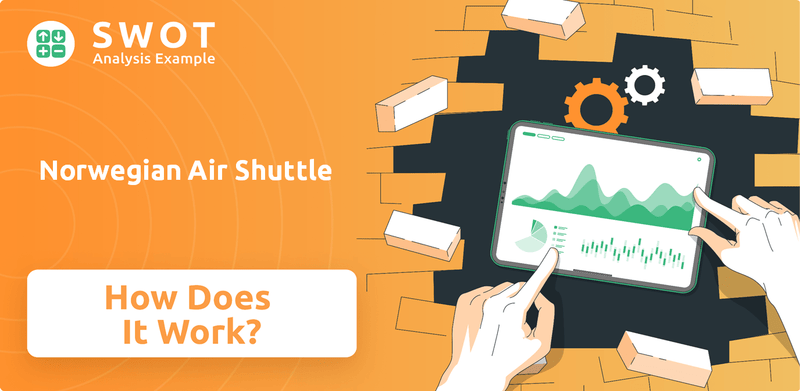
Norwegian Air Shuttle's strategic focus on cost efficiency and direct routes has allowed it to navigate challenges, including fluctuating fuel prices and global events. Its financial health is crucial for investors, customers, and industry observers. To gain a deeper understanding of its competitive advantages, consider a detailed analysis of its Norwegian Air Shuttle SWOT Analysis, which reveals its strengths and weaknesses. This examination will explore its core operations, value proposition, and responses to market shifts, offering insights into how Norwegian Air operates as a budget airline.
What Are the Key Operations Driving Norwegian Air Shuttle’s Success?
Norwegian Air Shuttle, often referred to as Norwegian Air, centers its core operations on providing affordable point-to-point air travel. The airline primarily focuses on routes within Europe, emphasizing high-frequency services and efficient aircraft utilization. This approach allows Norwegian airlines to cater to a broad customer base, including leisure travelers, business commuters, and individuals seeking budget-friendly options for both domestic and international journeys.
The value proposition of Norwegian Air Shuttle lies in offering competitive fares without compromising essential service quality. This strategy aims to make air travel accessible to a wider segment of the population. The airline differentiates itself by providing a comfortable experience, including Wi-Fi on many flights and a modern cabin environment, which sets it apart from ultra-low-cost carriers that may strip down amenities.
Norwegian Air's operational model emphasizes direct sales channels, primarily through its website and mobile app, to minimize distribution costs and maintain competitive pricing. The company leverages technology for route optimization and crew scheduling, contributing to its low-cost structure. Its supply chain focuses on efficient procurement of aircraft, maintenance services, and fuel, often through long-term agreements. While not extensively relying on traditional partnerships for network expansion like legacy carriers, Norwegian does engage in strategic alliances for specific services or codesharing agreements where beneficial.
Norwegian Air Shuttle employs streamlined online booking platforms and efficient ground handling to maintain operational efficiency. The airline utilizes a modern fleet of fuel-efficient aircraft, predominantly Boeing 737s, to optimize its operational costs. This approach contributes to the low-cost carrier's ability to offer competitive fares while still providing a satisfactory travel experience.
Norwegian Air focuses on disciplined cost control and digital innovation to enhance customer experience. The airline aims to offer a comfortable experience despite its low-cost model, providing Wi-Fi on many flights and a modern cabin environment. This blend of affordability and a satisfactory travel experience differentiates it from ultra-low-cost carriers.
As of late 2024, Norwegian Air Shuttle operates a fleet of approximately 80 aircraft, primarily Boeing 737s. The airline serves a network of destinations across Europe and select international routes. The fleet size and route network are subject to change based on market conditions and strategic decisions.
Norwegian Air Shuttle has demonstrated a commitment to financial recovery. Recent financial reports indicate improvements in revenue and passenger numbers. The airline's ability to manage costs and optimize its operations has been crucial for its financial stability. For detailed insights, you can explore the Marketing Strategy of Norwegian Air Shuttle.
Norwegian Air's success hinges on several key operational aspects that contribute to its low-cost structure and customer satisfaction. These include efficient fleet management, direct customer engagement, and strategic route planning.
- Efficient Fleet Management: Optimizing aircraft utilization and maintenance schedules to minimize costs.
- Direct Customer Engagement: Utilizing online platforms and mobile apps to reduce distribution expenses.
- Strategic Route Planning: Focusing on high-frequency routes and point-to-point travel to maximize efficiency.
- Cost Control: Implementing measures to manage fuel costs, labor expenses, and other operational expenditures.
Norwegian Air Shuttle SWOT Analysis
- Complete SWOT Breakdown
- Fully Customizable
- Editable in Excel & Word
- Professional Formatting
- Investor-Ready Format
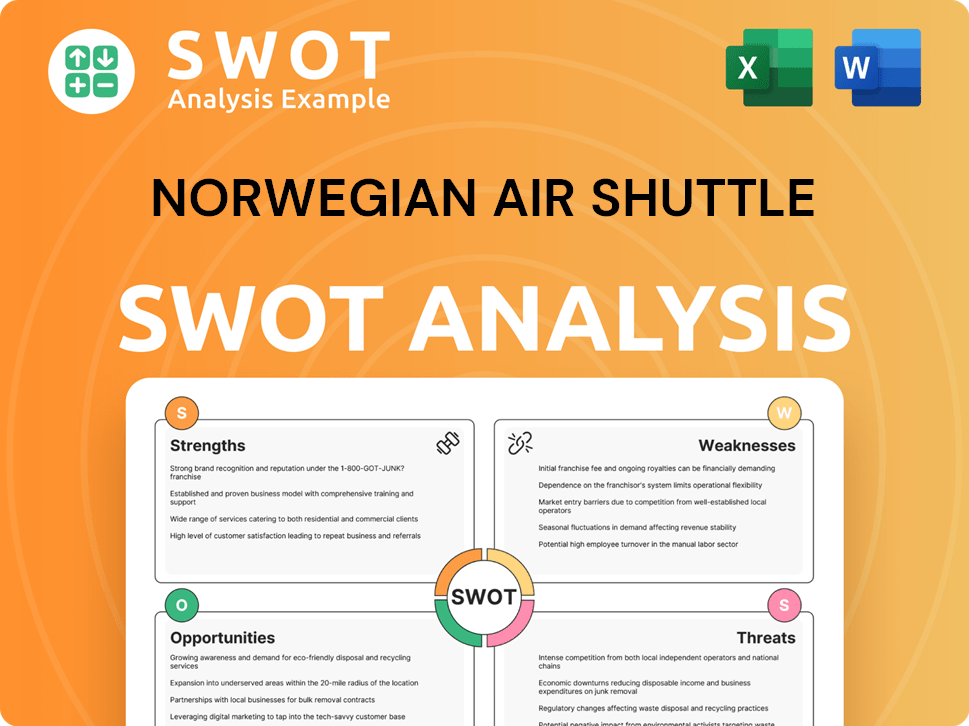
How Does Norwegian Air Shuttle Make Money?
Norwegian Air Shuttle, a prominent player in the budget airline sector, primarily generates revenue through ticket sales. This includes the base fares for flights and various ancillary services that enhance the passenger experience. In the first quarter of 2024, the company reported a total revenue of approximately 4.9 billion Norwegian Kroner, which translates to around 450 million USD, with passenger revenue as the main contributor.
The airline employs a multifaceted approach to boost its revenue per passenger. These strategies include a range of ancillary services, such as baggage fees, seat selection, and in-flight purchases, which provide significant supplementary income. Additionally, Norwegian Air Shuttle also earns from cargo services, though this contributes a smaller percentage compared to passenger operations.
Innovative pricing models and dynamic pricing strategies are key to maximizing revenue. These methods help the airline optimize earnings by adjusting prices based on demand and booking patterns. The majority of Norwegian Air Shuttle's revenue is derived from its European network, reflecting its core operational focus. For a deeper understanding of the airline's origins, you can explore the Brief History of Norwegian Air Shuttle.
Norwegian Air Shuttle uses several methods to generate income and enhance its profitability. These strategies are crucial for the airline’s financial performance and ability to offer competitive prices.
- Ticket Sales: The primary revenue source, encompassing both base fares and different fare classes.
- Ancillary Revenue: Fees from baggage, seat selection, priority boarding, and in-flight services.
- Dynamic Pricing: Adjusting ticket prices based on demand, seasonality, and booking lead times.
- Cargo Services: Revenue generated from transporting freight, though a smaller portion of overall income.
- Route Optimization: Focusing on high-demand routes within Europe to maximize passenger revenue.
Norwegian Air Shuttle PESTLE Analysis
- Covers All 6 PESTLE Categories
- No Research Needed – Save Hours of Work
- Built by Experts, Trusted by Consultants
- Instant Download, Ready to Use
- 100% Editable, Fully Customizable
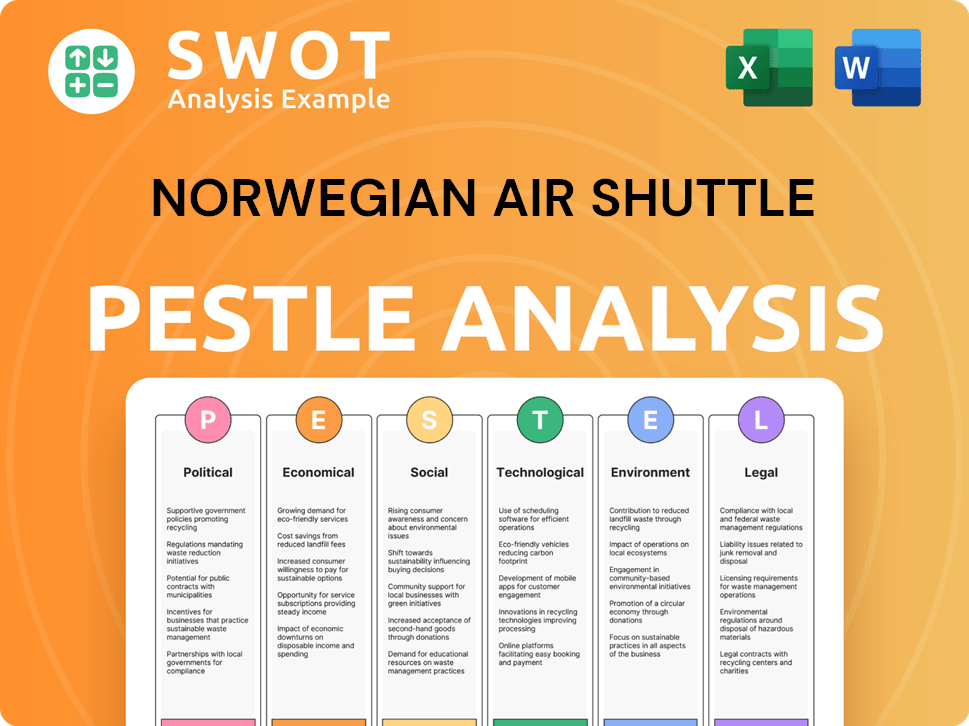
Which Strategic Decisions Have Shaped Norwegian Air Shuttle’s Business Model?
Norwegian Air Shuttle, a prominent player in the budget airline sector, has navigated a complex journey of strategic shifts and operational adjustments. The company's evolution reflects its responses to market dynamics, economic pressures, and competitive challenges. Understanding its key milestones, strategic moves, and competitive advantages is crucial for assessing its current position and future prospects. This analysis provides insights into how Norwegian Air has adapted to the ever-changing aviation landscape.
The airline's history is marked by significant transformations, including ambitious expansions and strategic pivots. A key strategic move was its foray into long-haul routes, which, while initially promising, proved challenging. This led to a refocus on its core short-haul European network, a crucial operational adjustment. The COVID-19 pandemic further tested the company, necessitating restructuring and fleet adjustments. These changes helped Norwegian Air emerge as a more streamlined and focused entity.
Operational challenges, such as fluctuating fuel prices and intense competition, have shaped Norwegian Air's strategies. The airline has prioritized cost efficiency, streamlined its route network, and invested in fuel-efficient aircraft to counter these challenges. Its competitive edge lies in its strong brand recognition in the Nordic region, a modern fleet, and an efficient point-to-point operational model. These factors enable the airline to maintain competitive fares and negotiate favorable supplier terms. For a deeper dive into their strategic approach, consider exploring the Growth Strategy of Norwegian Air Shuttle.
Norwegian Air Shuttle began as a regional airline but rapidly expanded its operations. The mid-2010s saw a push into long-haul flights, a strategic move that later proved challenging. The COVID-19 pandemic forced significant restructuring, including fleet reductions and recapitalization.
The airline's strategic moves include expanding into long-haul routes and later refocusing on short-haul European operations. During the pandemic, Norwegian Air undertook substantial restructuring to improve its financial stability. The company continues to invest in digital transformation to enhance customer experience.
Norwegian Air benefits from strong brand recognition, particularly in the Nordic region. Its modern and standardized fleet helps reduce maintenance costs. The efficient point-to-point operational model allows for competitive pricing.
The airline faces challenges from fluctuating fuel prices and intense competition from other low-cost carriers. Managing a large and diverse fleet presents its own complexities. Norwegian Air responds by prioritizing cost efficiency and streamlining its operations.
In 2024, Norwegian Air Shuttle has focused on strengthening its financial position and operational efficiency. The airline's fleet size is approximately 85 aircraft as of late 2024. The company has reported improved load factors, with an average of around 85% in recent quarters. Norwegian Air is also investing in sustainable aviation fuel and optimizing flight paths to reduce its environmental impact.
- Fleet Modernization: Continued investment in fuel-efficient aircraft.
- Route Optimization: Focus on profitable routes within Europe.
- Digital Enhancements: Improvements to booking platforms and mobile app.
- Sustainability Initiatives: Focus on reducing carbon emissions.
Norwegian Air Shuttle Business Model Canvas
- Complete 9-Block Business Model Canvas
- Effortlessly Communicate Your Business Strategy
- Investor-Ready BMC Format
- 100% Editable and Customizable
- Clear and Structured Layout
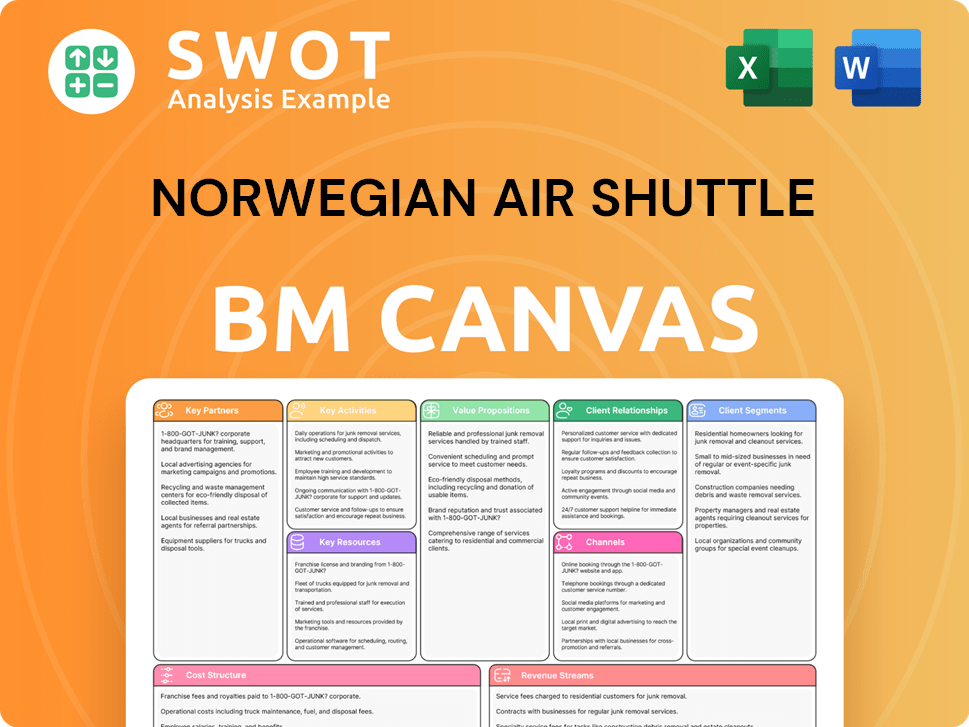
How Is Norwegian Air Shuttle Positioning Itself for Continued Success?
Norwegian Air Shuttle, often referred to as Norwegian airlines, holds a strong position in the European low-cost carrier market. It has a significant presence, particularly in the Nordic countries, and operates a substantial network of routes across Europe. The airline's focus on value and a relatively modern fleet contributes to its customer loyalty and market share.
Several risks could impact Norwegian Air's operations. These include fluctuating fuel prices, intense competition from other budget airlines like Ryanair and easyJet, and regulatory changes. Moreover, economic downturns and geopolitical events can significantly affect leisure travel demand, which is a core segment for the airline.
Norwegian Air Shuttle is a major player in the European low-cost airline sector. It has a strong presence in the Nordic region and a wide network of routes. The airline competes with other budget carriers, focusing on providing value to its customers.
Norwegian Air faces risks from fuel price volatility, intense competition, and regulatory changes. Economic downturns and geopolitical events can also affect leisure travel. These factors can impact the airline's profitability and operational capabilities.
Norwegian Air Shuttle focuses on optimizing its route network and investing in technology. The airline aims to maintain sustainable growth by managing costs and adapting to industry changes. This involves leveraging its brand and efficient operations.
The company is working on improving operational efficiency and customer experience. They are also committed to sustainable growth initiatives. This includes fleet modernization and exploring sustainable aviation practices to ensure future success.
In recent financial reports, Norwegian Air Shuttle has shown improvements in passenger numbers and revenue. The airline continues to manage its costs and adapt its strategies to remain competitive in the market. Key performance indicators (KPIs) such as load factors and on-time performance are closely monitored to ensure operational efficiency.
- Norwegian Air Shuttle has been focused on increasing its operational efficiency.
- Fleet modernization is a key part of their strategy to reduce costs and improve sustainability.
- The airline is actively managing its route network to focus on profitable and high-demand routes.
- Customer experience enhancements are a priority to build loyalty and attract passengers.
Norwegian Air Shuttle Porter's Five Forces Analysis
- Covers All 5 Competitive Forces in Detail
- Structured for Consultants, Students, and Founders
- 100% Editable in Microsoft Word & Excel
- Instant Digital Download – Use Immediately
- Compatible with Mac & PC – Fully Unlocked
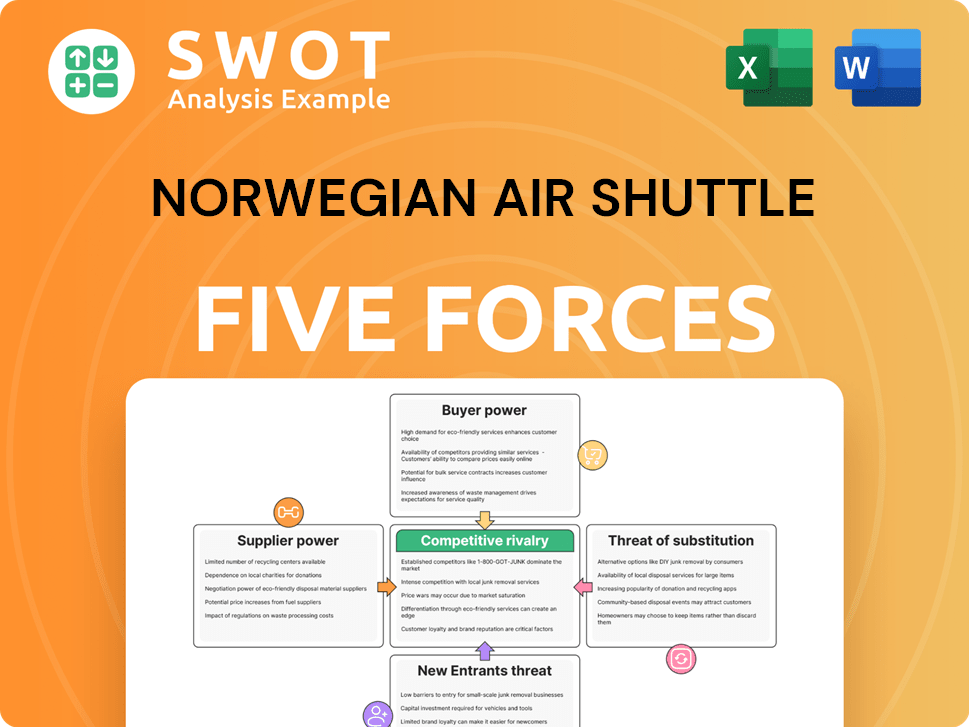
Related Blogs
- What are Mission Vision & Core Values of Norwegian Air Shuttle Company?
- What is Competitive Landscape of Norwegian Air Shuttle Company?
- What is Growth Strategy and Future Prospects of Norwegian Air Shuttle Company?
- What is Sales and Marketing Strategy of Norwegian Air Shuttle Company?
- What is Brief History of Norwegian Air Shuttle Company?
- Who Owns Norwegian Air Shuttle Company?
- What is Customer Demographics and Target Market of Norwegian Air Shuttle Company?
Disclaimer
All information, articles, and product details provided on this website are for general informational and educational purposes only. We do not claim any ownership over, nor do we intend to infringe upon, any trademarks, copyrights, logos, brand names, or other intellectual property mentioned or depicted on this site. Such intellectual property remains the property of its respective owners, and any references here are made solely for identification or informational purposes, without implying any affiliation, endorsement, or partnership.
We make no representations or warranties, express or implied, regarding the accuracy, completeness, or suitability of any content or products presented. Nothing on this website should be construed as legal, tax, investment, financial, medical, or other professional advice. In addition, no part of this site—including articles or product references—constitutes a solicitation, recommendation, endorsement, advertisement, or offer to buy or sell any securities, franchises, or other financial instruments, particularly in jurisdictions where such activity would be unlawful.
All content is of a general nature and may not address the specific circumstances of any individual or entity. It is not a substitute for professional advice or services. Any actions you take based on the information provided here are strictly at your own risk. You accept full responsibility for any decisions or outcomes arising from your use of this website and agree to release us from any liability in connection with your use of, or reliance upon, the content or products found herein.